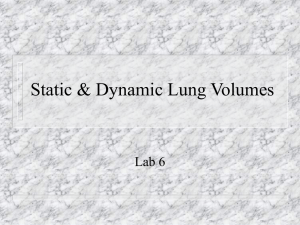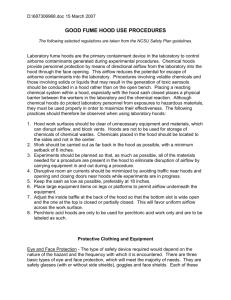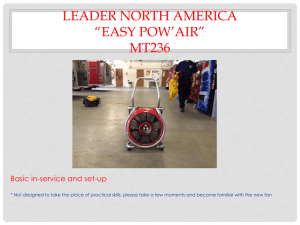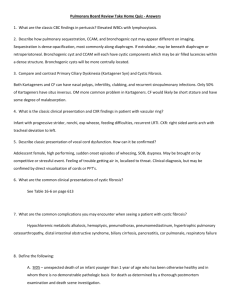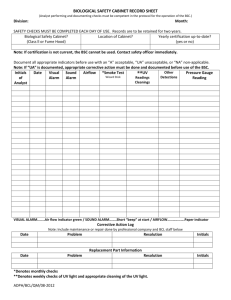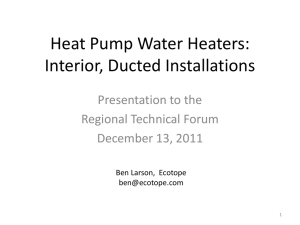Phoenix Controls Laboratory Airflow Control - aap
advertisement
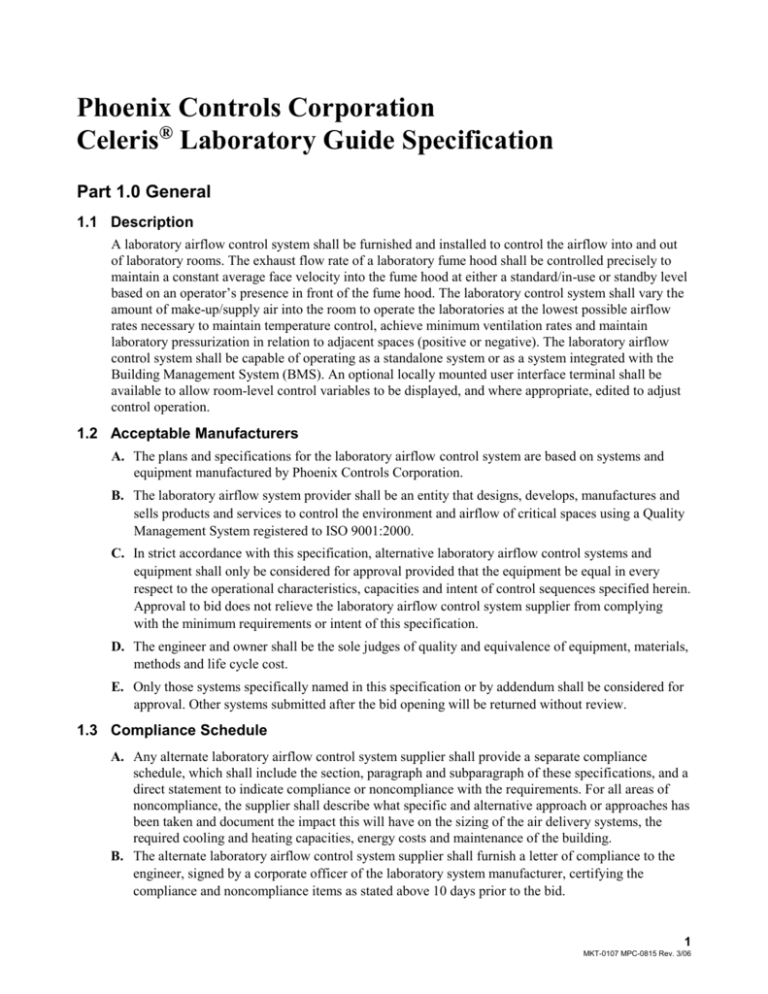
Phoenix Controls Corporation Celeris® Laboratory Guide Specification Part 1.0 General 1.1 Description A laboratory airflow control system shall be furnished and installed to control the airflow into and out of laboratory rooms. The exhaust flow rate of a laboratory fume hood shall be controlled precisely to maintain a constant average face velocity into the fume hood at either a standard/in-use or standby level based on an operator’s presence in front of the fume hood. The laboratory control system shall vary the amount of make-up/supply air into the room to operate the laboratories at the lowest possible airflow rates necessary to maintain temperature control, achieve minimum ventilation rates and maintain laboratory pressurization in relation to adjacent spaces (positive or negative). The laboratory airflow control system shall be capable of operating as a standalone system or as a system integrated with the Building Management System (BMS). An optional locally mounted user interface terminal shall be available to allow room-level control variables to be displayed, and where appropriate, edited to adjust control operation. 1.2 Acceptable Manufacturers A. The plans and specifications for the laboratory airflow control system are based on systems and equipment manufactured by Phoenix Controls Corporation. B. The laboratory airflow system provider shall be an entity that designs, develops, manufactures and sells products and services to control the environment and airflow of critical spaces using a Quality Management System registered to ISO 9001:2000. C. In strict accordance with this specification, alternative laboratory airflow control systems and equipment shall only be considered for approval provided that the equipment be equal in every respect to the operational characteristics, capacities and intent of control sequences specified herein. Approval to bid does not relieve the laboratory airflow control system supplier from complying with the minimum requirements or intent of this specification. D. The engineer and owner shall be the sole judges of quality and equivalence of equipment, materials, methods and life cycle cost. E. Only those systems specifically named in this specification or by addendum shall be considered for approval. Other systems submitted after the bid opening will be returned without review. 1.3 Compliance Schedule A. Any alternate laboratory airflow control system supplier shall provide a separate compliance schedule, which shall include the section, paragraph and subparagraph of these specifications, and a direct statement to indicate compliance or noncompliance with the requirements. For all areas of noncompliance, the supplier shall describe what specific and alternative approach or approaches has been taken and document the impact this will have on the sizing of the air delivery systems, the required cooling and heating capacities, energy costs and maintenance of the building. B. The alternate laboratory airflow control system supplier shall furnish a letter of compliance to the engineer, signed by a corporate officer of the laboratory system manufacturer, certifying the compliance and noncompliance items as stated above 10 days prior to the bid. 1 MKT-0107 MPC-0815 Rev. 3/06 Phoenix Controls Corporation Celeris® Laboratory Guide Specification 1.4 Technical Proposal Any alternate laboratory airflow control system supplier shall submit a detailed technical proposal for the owner’s evaluation at the time of submitting the compliance schedule described in section 1.3. The proposal shall describe the manner of compliance with this minimum performance specification, with particular emphasis on the following areas: diversity and energy analysis, proposed equipment, experience and performance verification. This proposal shall be separate from any BMS proposal(s), and it shall include the scope of information and services detailed in paragraphs A through D of this subsection. A. Diversity and Energy Analysis 1. Diversity analysis of the sizing of the ductwork, fans, air handlers, chillers, and boilers for the laboratory spaces. The analysis shall be based upon: Number of Hoods Occupied Hours User Presence Hours Sash Position–User Present Sash Position (a)–User Absent Sash Position (b)–User Absent CFM/Ton Cooling = = = = = See plans * * 100% 100% = 50% = 175 or * The analysis shall provide: Required Exhaust Capacity per Manifold (in CFM) Required Supply Capacity per Manifold (in CFM) Required Cooling Capacity (in tons) w/user absent sash position (a) w/user absent sash position (b) w/user absent sash position (a) w/user absent sash position (b) w/user absent sash position (a) w/user absent sash position (b) 2. Energy analysis for the laboratory spaces. The analysis shall be based upon: Number of hoods Occupied Hours User Presence Hours Sash Position–User Present Sash Position (a)–User Absent Sash Position (b)–User Absent $/CFM = = = = = See plans * * 100% 100% = 50% = * The analysis shall provide: Energy Costs w/user absent sash position (a) w/user absent sash position (b) * Actual project parameters as defined by the owner or consulting engineer 2 Rev. 3/06 MKT-0107 MPC-0815 Phoenix Controls Corporation Celeris® Laboratory Guide Specification B. Proposed Equipment 1. The laboratory airflow control system supplier shall provide a detailed proposal describing all elements of the laboratory control system. A schematic laboratory layout shall be provided, showing relations of these elements and a description of how they interact. 2. Technical specification data sheets shall be provided for all proposed system components and devices. 3. All proposed airflow control devices shall include discharge, exhaust and radiated sound power level performance obtained from testing in accordance with ARI Standard 880. C. Experience 1. The laboratory airflow control system supplier shall provide a list of at least three similar laboratory airflow control systems installed in the state or province as part of this proposal. 2. The laboratory airflow control system supplier shall provide the names, addresses and telephone numbers of the consulting engineer and the owner’s representative for each of these installations. It is understood that these individuals may be contacted regarding timely delivery, the quality of installation, the operation and performance of the equipment and the service requirements for each installation. Unsatisfactory performance or inability to provide references shall be grounds for rejection. D. Performance Verification The laboratory airflow control system supplier shall demonstrate a typical laboratory space that includes multiple fume hoods, a general exhaust and a supply airflow control device for the purpose of verifying the laboratory airflow control system’s ability to meet the performance requirements indicated in this specification. All travel and lodging costs to witness the performance verification shall be the responsibility of the laboratory airflow control system supplier. 1.5 Preventive Maintenance The laboratory airflow control system supplier shall provide at no additional cost to the owner during and after the warranty period five years of required preventive maintenance on all airflow sensors (e.g., pitot tube, flow cross, orifice ring, air bar, hot wire, vortex shedder, side wall sensors, etc.) and flow transducers provided under this section. Airflow sensors shall be removed, inspected, and cleaned annually during the five-year period to prevent inaccuracies due to long-term buildup from corrosion, lab tissues, wet or sticky particles, or other materials that foul the sensor. If impractical to remove the airflow sensors, the laboratory airflow control system supplier shall include in the proposal the cost of supplying and installing duct access doors, one for each sensor. The transducer shall be checked and recalibrated annually to ensure long-term accuracy. Note that auto-zero recalibration of transducers is not acceptable as a substitute for annual recalibration. 1.6 Warranty Period Warranty shall commence upon the date of shipment and extend for a period of 36 months, whereupon any defects in materials or laboratory airflow control system performance shall be repaired by the supplier at no cost to the owner. Part 2.0 System Performance Requirements 2.1 Airflow Control System Description 3 MKT-0107 MPC-0815 Rev. 3/06 Phoenix Controls Corporation Celeris® Laboratory Guide Specification A. Each laboratory shall have a dedicated laboratory airflow control system. Each dedicated laboratory airflow control system shall support a minimum of 20 network controlled airflow devices. B. The laboratory airflow control system shall employ individual average face velocity controllers that directly measure the area of the fume hood sash opening and proportionally control the hood’s exhaust airflow to maintain a constant face velocity over a minimum range of 20% to 100% of sash travel. The corresponding minimum hood exhaust flow turndown ratio shall be 5 to 1. C. The hood exhaust airflow control device shall respond to the fume hood sash opening by achieving 90% of its commanded value within one second of the sash reaching 90% of its final position (with no more than 5% overshoot/undershoot) of required airflow. Rate of sash movement shall be from one to one and one-half feet per second. D. The hood exhaust airflow control device shall be switched automatically between in-use and standby levels based on the operator’s presence immediately in front of the hood. A presence and motion sensor shall activate the switching. The airflow control device shall achieve the required inuse commanded value in less than one second from the moment of detection with no more than a 5% overshoot or undershoot. E. The laboratory airflow control system shall maintain specific airflow (±5% of signal within one second of a change in duct static pressure) regardless of the magnitude of the pressure change, airflow change or quantity of airflow control devices on the manifold (within 0.6" to 3.0" wc). F. The laboratory airflow control system shall use volumetric offset control to maintain room pressurization. The system shall maintain proper room pressurization polarity (negative or positive) regardless of any change in room/system conditions, such as the raising and lowering of any or all fume hood sashes or rapid changes in duct static pressure. Systems using differential pressure measurement or velocity measurement to control room pressurization are unacceptable. G. The laboratory airflow control system shall maintain specific airflow (±5% of signal) with a minimum 16 to 1 turndown to ensure accurate pressurization at low airflow and guarantee the maximum system diversity and energy efficiency. 2.2 Airflow Control Sound Specification A. Unless otherwise specified, the airflow control device shall not exceed the sound power levels in Tables 1, 2 and 3. B. If the airflow control device cannot meet the sound power level specification, a properly sized silencer or sound attenuator must be used. All silencers must be of a packless design (constructed of at least 18 gauge 316L stainless steel when used with fume hood exhaust) with a maximum pressure drop at the device’s maximum rated flow rate not to exceed 0.20 inches of water. C. All proposed airflow control devices shall include discharge, exhaust and radiated sound power level performance. 4 Rev. 3/06 MKT-0107 MPC-0815 Phoenix Controls Corporation Celeris® Laboratory Guide Specification Table 1. Exhaust Airflow Control Device Sound Power Level Exhaust Sound Power Level in dB (re: 10-12 watts) 2 3 4 5 6 7 125 Hz 250 Hz 500 Hz 1000 Hz 2000 Hz 4000 Hz 1000-50 CFM Device 800 CFM @ 0.6" wc 200 CFM @ 0.6" wc 800 CFM @ 3.0" wc 200 CFM @ 3.0" wc 63 46 73 51 55 42 70 52 52 38 64 51 54 37 66 50 50 32 65 52 49 25 60 51 1500-100 CFM Device 1200 CFM @ 0.6" wc 400 CFM @ 0.6" wc 1200 CFM @ 3.0" wc 400 CFM @ 3.0" wc 65 50 72 55 58 45 70 57 53 38 62 55 56 39 65 53 52 37 64 56 52 31 60 55 3000-200 CFM Device 2400 CFM @ 0.6" wc 800 CFM @ 0.6" wc 2400 CFM @ 3.0" wc 800 CFM @ 3.0" wc 63 51 75 58 56 45 71 58 55 41 65 56 58 42 68 56 54 39 67 59 55 34 63 58 Octave Band Number Center Frequency in Hz Table 2. Supply Airflow Control Device Sound Power Level (Discharge) Discharge Sound Power Level in dB(re: 10-12 watts) 2 3 4 5 6 7 125 Hz 250 Hz 500 Hz 1000 Hz 2000 Hz 4000 Hz 1000-50 CFM Device 800 CFM @ 0.6" wc 200 CFM @ 0.6" wc 800 CFM @ 3.0" wc 200 CFM @ 3.0" wc 62 45 72 53 57 46 71 56 54 42 67 54 58 44 75 58 54 40 72 56 51 34 68 54 1500-100 CFM Device 1200 CFM @ 0.6" wc 400 CFM @ 0.6" wc 1200 CFM @ 3.0" wc 400 CFM @ 3.0" wc 63 53 72 58 59 49 73 63 55 44 69 61 60 49 77 63 54 45 72 60 53 39 68 57 3000-200 CFM Device 2400 CFM @ 0.6" wc 800 CFM @ 0.6" wc 2400 CFM @ 3.0" wc 800 CFM @ 3.0" wc 64 52 75 59 60 48 75 62 58 47 72 62 63 52 78 66 56 46 73 62 56 41 70 60 Octave Band Number Center Frequency in Hz Table 3. Supply Airflow Control Device Sound Power Level (Radiated) Radiated Sound Power Level in dB (re: 10-12 watts) 5 MKT-0107 MPC-0815 Rev. 3/06 Phoenix Controls Corporation Celeris® Laboratory Guide Specification 2 3 4 5 6 7 125 Hz 250 Hz 500 Hz 1000 Hz 2000 Hz 4000 Hz 1000-50 CFM Device 800 CFM @ 0.6" wc 200 CFM @ 0.6" wc 800 CFM @ 3.0" wc 200 CFM @ 3.0" wc 44 33 53 41 41 28 53 38 45 31 56 41 41 29 57 39 36 26 55 39 34 20 53 37 1500-100 CFM Device 1200 CFM @ 0.6" wc 400 CFM @ 0.6" wc 1200 CFM @ 3.0" wc 400 CFM @ 3.0" wc 47 35 52 42 53 39 60 44 40 31 54 43 42 34 60 46 38 33 59 46 36 26 53 42 3000-200 CFM Device 2400 CFM @ 0.6" wc 800 CFM @ 0.6" wc 2400 CFM @ 3.0" wc 800 CFM @ 3.0" wc 58 45 69 54 56 43 68 53 45 36 60 48 47 39 65 51 43 37 63 50 42 29 57 48 Octave Band Number Center Frequency in Hz Part 3.0 System Components 3.1 Usage Based Control® Equipment A. For variable air volume (VAV) systems, a sash sensor shall be provided to measure the height of each vertically moving fume hood sash. A sash sensor shall also be provided for horizontal overlapping sashes. Control systems employing sidewall-mounted velocity sensors shall be unacceptable. B. A presence and motion sensor shall be provided to determine an operator’s presence in front of a hood by detecting the presence and/or motion of an operator, and to command the laboratory airflow control system from an in-use operating face velocity (e.g., 100 fpm) to a standby face velocity (e.g., 60 fpm) and vice versa. 1. The sensor shall define a detection zone that extends approximately 20" (50 cm) from the front of the fume hood. If the sensor does not detect presence and/or motion in its detection zone within five seconds, it shall command the system to the user-adjustable standby face velocity. When the sensor detects the presence and/or motion of an operator within the detection zone, it shall command the system to the in-use face velocity within one second. 2. The sensor shall have a control circuit that adapts to its specific surroundings and adjusts automatically for inanimate objects placed within its detection zone. It shall map the area into memory and, after a period of five minutes, nullify the image of the inanimate object and return to a standby mode. When operators enter and leave the zone, the unit shall adjust automatically between in-use and standby modes. If the inanimate object is moved or taken out of the zone, the unit shall re-map the area automatically. 3. Wide area motion detectors (on the hood or room level) shall be unacceptable. 6 Rev. 3/06 MKT-0107 MPC-0815 Phoenix Controls Corporation Celeris® Laboratory Guide Specification C. The airflow at the fume hood shall vary in a linear manner between two adjustable minimum and maximum flow set points to maintain a constant face velocity throughout this range. A minimum volume flow shall be set to assure flow through the fume hood even with the sash totally closed. D. A fume hood monitor shall be provided to receive the sash sensor output and presence and/or motion signal. This same monitor shall generate an exhaust airflow control signal for the appropriate airflow control device in order to provide a constant average face velocity. Audible and separate visual alarms shall be provided for both flow alarm and emergency exhaust conditions. 3.2 Airflow Control Device—General A. The airflow control device shall be a venturi valve. B. The valve assembly manufacturer’s Quality Management System shall be registered to ISO 9001:2000. C. The airflow control device shall be pressure independent over its specified differential static pressure operating range. An integral pressure independent assembly shall respond and maintain specific airflow within one second of a change in duct static pressure irrespective of the magnitude of pressure and/or flow change or quantity of airflow controllers on a manifolded system. D. The airflow control device shall maintain accuracy within ±5% of signal over an airflow turndown range of no less than 16 to 1. E. No minimum entrance or exit duct diameters shall be required to ensure accuracy and/or pressure independence. F. The airflow control device shall be constructed of one of the following three types: 1. Class A—The airflow control device for non-corrosive airstreams, such as supply and general exhaust, shall be constructed of 16-gauge aluminum. The device's shaft and shaft support brackets shall be made of 316 stainless steel. The pivot arm and internal mounting link shall be made of aluminum. The pressure independent springs shall be a spring-grade stainless steel. All shaft bearing surfaces shall be made of a Teflon, polyester or PPS (polyphenylene sulfide) composite. Sound attenuating devices used in conjunction with general exhaust or supply airflow control devices shall be constructed using 24 gauge galvanized steel or other suitable material used in standard duct construction. No sound absorptive materials of any kind shall be used. 2. Class B—The airflow control device for corrosive airstreams, such as fume hoods and biosafety cabinets, shall have a baked-on, corrosion-resistant phenolic coating. The device's shaft shall be made of 316 stainless steel with a Teflon coating. The shaft support brackets shall be made of 316 stainless steel. The pivot arm and internal mounting link shall be made of 316 or 303 stainless steel. The pressure independent springs shall be a spring-grade stainless steel. The internal nuts, bolts and rivets shall be stainless steel. All shaft bearing surfaces shall be made of a Teflon or PPS (polyphenylene sulfide) composite. 3. Class C—The airflow control device for highly corrosive airstreams shall be constructed as defined in Paragraph E.2. In addition, these devices shall have no exposed aluminum or stainless steel components. Shaft support brackets, pivot arm, internal mounting link, and pressure independent springs shall have a baked-on, corrosion-resistant phenolic coating in addition to the materials defined in paragraph E.2. The internal nuts, bolts, and rivets shall be 7 MKT-0107 MPC-0815 Rev. 3/06 Phoenix Controls Corporation Celeris® Laboratory Guide Specification titanium or phenolic coated stainless steel. Only devices clearly defined as “high corrosion resistant” on project drawings will require this construction. G. Actuation 1. For pneumatically-actuated two-position or VAV operation, a pneumatic actuator shall be factory mounted to the valve. Loss of pneumatic main air or control power shall cause normally open valves to fail to maximum position and normally closed valves to fail to minimum position. 2. For electrically actuated VAV operation, a UL 916 listed electronic actuator shall be factory mounted to the valve. Loss of main power shall cause the valve to position itself in an appropriate failsafe state. Options for these failsafe states include: normally open-maximum position, normally closed-minimum position and last position. This position shall be maintained constantly without external influence, regardless of external conditions on the valve (within product specifications). 3. Constant volume valves do not require actuators. H. The controller for the airflow control devices shall be microprocessor based and operate using peerto-peer control architecture. The room-level airflow control devices shall function as a standalone network. I. The room-level control network shall utilize a LonTalk communications protocol. J. There shall be no reliance on external or building-level control devices to perform room-level control functions. Each laboratory control system shall have the capability of performing fume hood control, pressurization control, temperature control, humidity control, and implement occupancy and emergency mode control schemes. K. The laboratory airflow control systems shall have the option of digital integration with the BMS. L. Certification 1. Each airflow control device shall be factory calibrated to the job specific airflows as detailed on the plans and specifications using NIST traceable air stations and instrumentation having a combined accuracy of no more than ±1% of signal over the entire range of measurement. Electronic airflow control devices shall be further calibrated and their accuracy verified to ±5% of signal at a minimum of 48 different airflows across the full operating range of the device. 2. Each airflow control devices shall be marked with device-specific factory calibration data. At a minimum, it should include the tag number, serial number, model number, eight-point characterization information (for electronic devices), and quality control inspection numbers. All information shall be stored by the manufacturer for use with as-built documentation. M. Airflow control devices that are not venturi valves and airflow measuring devices (e.g., pitot tube, flow cross, air bar, orifice ring, vortex shedder, etc.) shall only be acceptable, provided these meet all the performance and construction characteristics as stated throughout this specification and: 1. The airflow control device employs transducers manufactured by Rosemount, Bailey, Bristol, or Foxboro. Accuracy shall be no less than ±0.15% of span (to equal ±5% of signal with a 15 to one turndown) over the appropriate full-scale range, including the combined effects of nonlinearity, hysteresis, repeatability, drift over a one-year period, and temperature effect. 316L stainless steel materials shall be provided for all exhaust applications. The use of 304 stainless steel materials shall be provided for all make-up air applications. 8 Rev. 3/06 MKT-0107 MPC-0815 Phoenix Controls Corporation Celeris® Laboratory Guide Specification 2. Airflow sensors shall be of a multi-point averaging type, 304 stainless steel for all supply and general exhaust applications, 316L stainless steel for all fume hood, canopy, snorkel, and biosafety cabinet applications. Single point sensors are not acceptable. 3. Suppliers of airflow control devices or airflow measuring devices requiring minimum duct diameters shall provide revised duct layouts showing the required straight duct runs upstream and downstream of these devices. Coordination drawings reflecting these changes shall be submitted by the supplier of the laboratory airflow control system. In addition, suppliers shall include static pressure loss calculations as part of their submittals. All costs to modify the ductwork, increase fan sizes and horsepower and all associated electrical changes shall be borne by the laboratory airflow control supplier. 3.3 Exhaust and Supply Airflow Device Controller A. The airflow control device shall be a microprocessor-based design and shall use closed loop control to linearly regulate airflow based on a digital control signal. The device shall generate a digital feedback signal that represents its airflow. B. The airflow control device shall store its control algorithms in non-volatile, re-writeable memory. The device shall be able to stand-alone or to be networked with other room-level digital airflow control devices using an industry standard protocol. C. Room-level control functions shall be embedded in and carried out by the airflow device controller using distributed control architecture. Critical control functions shall be implemented locally; no room-level controller shall be required. D. The airflow control device shall use industry standard 24 Vac power. E. The airflow control device shall have provisions to connect a notebook PC commissioning tool and every node on the network shall be accessible from any point in the system. F. The airflow control device shall have built-in integral input/output connections that address fume hood control, temperature control, humidity control occupancy control, emergency control, and non-network sensors switches and control devices. At a minimum, the airflow controller shall have: 1. Three universal inputs capable of accepting 0 to 10 Vdc, 4 to 20 mA, 0 to 65 K ohms, or Type 2 or Type 3 10 K ohm @ 25 degree C thermistor temperature sensors. 2. One digital input capable of accepting a dry contact or logic level signal input. 3. Two analog outputs capable of developing either a 0 to 10 Vdc or 4 to 20 mA linear control signal. 4. One Form C (SPDT) relay output capable of driving up to 1 A @ 24 Vac/Vdc. G. The airflow control device shall meet FCC Part 15 Subpart J Class A and be UL916 listed. 3.4 Two-position Exhaust Airflow Control Device The airflow control device shall maintain a factory calibrated fixed maximum and minimum flow set point based on a switched 0 to 20 psi pneumatic signal. Two-position devices requiring feedback shall generate a 0 to 10 volt feedback signal that is linearly proportional to its airflow. All two-position devices shall be either networked or hard-wired into the room-level network so as to be considered under pressurization control. 3.5 Laboratory Office Airflow Control Device 9 MKT-0107 MPC-0815 Rev. 3/06 Phoenix Controls Corporation Celeris® Laboratory Guide Specification The airflow control device shall maintain a temperature set point by controlling the airflow and the reheat valve (if required) in response to a room temperature sensor. An additional output shall be provided for supplementary cooling or heating of the office space. If the office airflow supply device is not required for make-up airflow control for fume hoods, then the one-second speed of response and fail-safe conditions required of the laboratory airflow control system shall not apply. 3.6 Constant Volume Airflow Control Device A. The airflow control device shall maintain a constant airflow set point. It shall be factory calibrated and set for the desired airflow. It shall also be capable of field adjustment for future changes in desired airflow. B. Laboratory airflow control systems suppliers not employing constant volume venturi airflow control valves shall provide pneumatic tubing or electrical wiring as required for their devices. 3.7 Closed Loop Variable Frequency Drive A. The drive shall be a high-performance pulse width modulated design, which generates a sine-coded, adjustable voltage/frequency, three-phase output for complete speed control of any conventional squirrel cage induction motor. B. The device shall not induce any voltage line notching distortion back to the utility line. The device shall maintain a displacement power factor of not less than 0.95 throughout its speed range. Synchronism between drive frequency and motor speed shall be maintained under all conditions. C. The drive shall restart a coasting motor automatically after a power outage of any duration without tripping or shutting down. The drive shall apply rated power to accelerate the motor to the commanded speed within 0.5 second of the reapplication of drive power or the removal of a motor fault condition. D. The drive shall accelerate the motor rapidly, limited only by the motor’s rated torque and load. E. An alarm circuit indicating low face velocity shall be included to electronically sense a loss of airflow via a drop in actual (not calculated) motor power or a difference between the actual and commanded motor speed. The alarm shall be enunciated through audible and visual means at the fume hood monitor. 3.8 Local Display Unit A. The control system shall have an optional local display option that allows control and system variables to be displayed on a user interface terminal device. The Local Display Unit shall connect to the room-level network and provide access to all room-level control data. B. The display unit shall be powered by 24 Vac or 24 Vdc. C. The Local Display Unit shall have the provisions of being flush mounted or surface mounted either directly to a standard electrical enclosure or DIN rail. Electrical conductors shall terminate inside the display module housing to a pluggable terminal block. D. The display unit shall utilize an LCD display with variable contrast adjustment and backlighting to adapt the display to various lighting conditions. E. The display unit shall provide a means of entering and displaying a unique location descriptor that may be used to identify the location and/or function of the display unit. The descriptor shall allow up to two lines of at least 13 alphanumeric characters to be entered in the description field. 10 Rev. 3/06 MKT-0107 MPC-0815 Phoenix Controls Corporation Celeris® Laboratory Guide Specification F. The display unit shall allow access to pertinent flow, temperature, humidity, pressure data, as well as occupancy and emergency mode control status, and current device or system alarm status. Data shall be viewable in units of measure appropriate for users of the system. 11 MKT-0107 MPC-0815 Rev. 3/06 Phoenix Controls Corporation Celeris® Laboratory Guide Specification G. The display unit shall have the ability to display up to 250 parameters, organized into display screens of up to five parameters per screen. Each screen shall have the ability to have a descriptive name of up to 16 alphanumeric characters for ease of navigation. Each parameter being displayed shall have the ability to include such information as: a. Descriptive tag (up to 13 alphanumeric characters). b. Present value, which may be read directly off the network, or conditioned with a fixed multiplier and/or offset to scale the value for the desired units of measure. c. Units of measure, which are configurable based on local user conventions. H. Set points and editable control parameters shall be viewable on the Local Display Unit. The user shall have the ability to enable a pass code to prevent unauthorized changes to set points and editable control parameters. 3.9 Control Functions A. The airflow control devices shall utilize peer-to-peer, distributed control architecture to perform room-level control functions. Master-slave control schemes shall not be acceptable. Control functions shall include, at a minimum, pressurization, temperature, humidity control, as well as respond to occupancy and emergency control commands. B. Pressurization Control The laboratory control system shall control supply and auxiliary exhaust airflow devices in order to maintain a volumetric offset (either positive or negative). Offset shall be maintained regardless of any change in flow or static pressure. This offset shall be field adjustable and represents the volume of air, which will enter (or exit) the room from the corridor or adjacent spaces. The pressurization control algorithm shall sum the flow values of all supply and exhaust airflow devices and command appropriate controlled devices to new set points to maintain the desired offset. The offset shall be adjustable. The pressurization control algorithm shall consider both networked devices, as well as: 1. Up to three non-networked devices providing a linear analog flow signal. 2. Any number of constant volume devices where the total of supply devices and the total of exhaust devices may be factored into the pressurization control algorithm. Volumetric offset shall be the only acceptable means of controlling room pressurization. Systems that rely on differential pressure as a means of control shall provide documentation to demonstrate that space pressurization can be maintained if fume hood sashes are changed at the same time a door to the space is opened. The pressurization control algorithm shall support the ability to regulate the distribution of total supply flow across multiple supply airflow control devices in order to optimize air distribution in the space. 12 Rev. 3/06 MKT-0107 MPC-0815 Phoenix Controls Corporation Celeris® Laboratory Guide Specification C. Temperature Control The laboratory control system shall regulate the space temperature through a combination of volumetric thermal override and control of reheat coils and/or auxiliary temperature control devices. The laboratory control system shall support up to four separate temperature zones for each pressurization zone. Each zone shall have provisions for monitoring up to five temperature inputs and calculating a straight-line average to be used for control purposes. Separate cooling and heating set points shall be writeable from the BMS, with the option of a local offset adjustment. Temperature control shall be implemented through the use of independent primary cooling and heating control functions, as well as an auxiliary temperature control function, which may be used for either supplemental cooling or heating. Cooling shall be provided as a function of thermal override of conditioned air with both supply and exhaust airflow devices responding simultaneously so as to maintain the desired offset. Heating shall be provided through modulating control of a properly sized reheat coil. The laboratory control system shall also provide the built-in capability for being configured for hot deck/cold deck temperature control. The auxiliary temperature control function shall offer the option of either heating or cooling mode and to operate as either a standalone temperature control loop, or staged to supplement the corresponding primary temperature control loop. D. Humidity Control The laboratory control system shall have an embedded humidity control function, which allows the monitoring and control of the relative humidity level in the pressurized zone. Using peer-to-peer control, the airflow devices shall have the ability to monitor the relative humidity level of the space and, based on a BMS writeable set point, develop a control signal to drive one or the other humidification or dehumidification control circuits. The humidity control loop(s) shall share a common set point, with a configurable deadband adjustment to prevent the humidification and dehumidification control functions to operate at the same time. E. Occupancy Control The laboratory control system shall have the ability to change the minimum ventilation and/or temperature control set points, based on the occupied state, in order to reduce energy consumption when the space is not occupied. The occupancy state may be set by either the BMS as a scheduled event or through the use of a local occupancy sensor or switch. The laboratory control system shall support a local occupancy override button that allows a user to override the occupancy mode and set the space to occupied for a predetermined interval. The override interval shall be configurable from one to 1440 minutes. The local occupancy sensor/switch or bypass button shall be given priority over a BMS command. F. Emergency Mode Control The laboratory control system shall provide a means of overriding temperature and pressurization control in response to a command indicating an emergency condition exists, and airflow control devices are to be driven to a specific flow set point. The system shall support up to four emergency control modes. The emergency control modes may be initiated either by a local contact input or BMS command. 13 MKT-0107 MPC-0815 Rev. 3/06 Phoenix Controls Corporation Celeris® Laboratory Guide Specification Once an emergency mode is invoked, pressurization and temperature control are overridden for the period that the mode is active. Emergency modes shall have a priority scheme allowing a more critical mode to override a previously set condition. G. Local Alarm Control The laboratory control system shall provide the means of summing selective alarm activity at the room-level network and generating a local alarm signal. The local alarm signal may be directed to any available output, as well as to the BMS. The alarm mask may be configured differently for each room-level system. H. Diversity Alarm The laboratory control system shall have the ability of monitoring the airflow values for the pressurized space and generating an alarm signal in the event the total exhaust flow exceeds a predetermined threshold. The diversity alarm is intended to allow the user to take diversity in the design and generate an alarm condition in the event the diversity threshold is compromised. This function must be available in either an integrated or standalone system. I. Fume Hood Control Airflow devices intended to control the face velocity of a fume hood shall have the ability to interface directly with the fume hood monitoring device. The airflow control device shall: 1. Accept command inputs to regulate the flow accordingly and make this command value available to the BMS. 2. Accept a sash position signal and make this value available to the BMS. 3. Accept a Usage Based Control signal to indicate user presence and make this signal available to the BMS. 4. Provide a flow feedback signal to the fume hood monitor, which may be used for calculating face velocity or to confirm the airflow device has achieved the proper flow rate and make this value available to the BMS. 5. Provide alarm signals to the fume hood monitor in the event the airflow device is unable to achieve the proper flow rate, there is a loss of static pressure indicating improper fan operation, or there is a loss of power to the airflow control device, in order to provide a local alarm indication. The fume hood airflow control device shall respond to changes in sash position and user presence within one second, in order to provide a constant 100-feet-per-minute face velocity when the fume hood is in use. M. The laboratory control system shall be segregated into subnets to isolate network communications to ensure room-level control functions and BMS communications are carried out reliably. Each laboratory space or pressurization zone shall be its own subnet. Commercially available routers shall be used to provide this isolation. N. The laboratory airflow control system shall support at least 20 networked devices in each pressurized zone. O. All points shall be available through the interface to the BMS for trending, archiving, graphics, alarm notification and status reports. Laboratory airflow control system performance (speed, 14 Rev. 3/06 MKT-0107 MPC-0815 Phoenix Controls Corporation Celeris® Laboratory Guide Specification stability and accuracy) shall be unaffected by the quantity of points being monitored, processed or controlled. P. Refer to the BMS specification for the required input/output summary for the necessary points to be monitored and/or controlled. 3.10 Interface to Building Management Systems A. The laboratory airflow control system network shall have the capability of digitally interfacing with the BMS. The required software interface drivers shall be developed and housed in a dedicated interface device furnished by the laboratory airflow control system supplier. B. All room-level points shall be available to the BMS for monitoring or trending. The gateway shall maintain a cache of all points to be monitored by the BMS. The room-level airflow control devices shall update this cache continually. C. The building-level network shall be a high-speed LonTalk (1.25 Mbps) communications protocol. The building-level network shall support up to 100 subnets or pressurization zones, or 6000 data points. D. A commercially available interface card shall be provided with the Accel-Way™ gateway in order to connect to the building-level network. E. A commercially available network interface card shall be provided with the gateway to interface with the BMS. Part 4.0 Execution 4.1 Installation A. The automatic temperature controls (ATC) contractor shall install the sash sensors, interface boxes, presence and motion sensor, and fume hood monitor on the fume hood under initial supervision of the laboratory airflow control system supplier. Reel-type sash sensors and their stainless steel cables shall be hidden from view. Bar-type sash sensors shall be affixed to the individual sash panels. Sash interface boxes with interface cards shall be mounted in an accessible location. B. The ATC contractor shall install all routers and repeaters in an accessible location in or around the designated laboratory room. C. The ATC shall install an appropriately sized and fused 24 Vac transformer suitable for NEC Class II wiring. D. The ATC contractor shall install 20 psi clean, dry pneumatic supply air to all airflow control devices, where required. E. All cable shall be furnished and installed by the ATC contractor. The ATC contractor shall terminate and connect all cables as required. The ATC shall utilize cables specifically recommended by the laboratory airflow controls supplier. F. The mechanical contractor shall install all airflow control devices in the ductwork and shall connect all airflow control valve linkages. G. The mechanical contractor shall provide and install all reheat coils and transitions. H. The mechanical contractor shall provide and install insulation as required. 15 MKT-0107 MPC-0815 Rev. 3/06 Phoenix Controls Corporation Celeris® Laboratory Guide Specification I. Each pressurization zone shall have either a dedicated, single-phase primary circuit or a secondary circuit disconnect. 16 Rev. 3/06 MKT-0107 MPC-0815 Phoenix Controls Corporation Celeris® Laboratory Guide Specification 4.2 System Start-up and Training A. System start-up shall be provided by a factory-authorized representative of the laboratory airflow control system manufacturer. Start-up shall include calibrating the fume hood monitor and any combination sash sensing equipment, as required. Start-up shall also provide electronic verification of airflow (fume hood exhaust, supply, make-up, general exhaust or return), system programming and integration to BMS (when applicable). B. The balancing contractor shall be responsible for final verification and reporting of all airflows. C. The laboratory airflow control system supplier shall furnish a minimum of eight hours of owner training by factory trained and certified personnel. The training will provide an overview of the job specific airflow control components, verification of initial fume hood monitor calibration, general procedures for verifying airflows of air valves and general troubleshooting procedures. D. Operation and maintenance manuals, including as-built wiring diagrams and component lists, shall be provided for each training attendee. 17 MKT-0107 MPC-0815 Rev. 3/06

